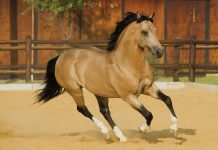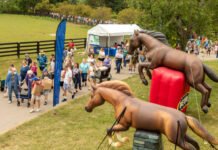5 Steps To Follow
Do you have a horse that doesn’t know how to jump? Maybe he’s a western pleasure horse and you’ve decided you’d like to ride him English-style. Maybe he’s a young, green horse that has never popped over a fence. If you are like most YR readers, you want to jump. Why? Because it’s fun!
Whoa!
Before you begin teaching your horse how to jump, you must make sure that he is sound (not lame) and in good health. Ask your parents and your instructor, if you have one, if they think he is fit enough to jump. Only jump under supervision—this means a grown-up should be nearby. Always wear an approved helmet with a fixed chinstrap. And make sure the fences and poles you are jumping are safe. Ask an instructor to check them out before you start jumping.
Step 1
Put a few poles on the ground around your arena. Incorporate them into your everyday schooling regime. If you are trotting a circle, trot a circle with a pole in it so your horse has to trot over the pole. If you are cantering down the long side of the arena, place a pole where you can canter over it easily.
Don’t get into jumping position when you jump—you don’t want your horse to actually jump over the pole, just walk or trot over it as if it isn’t there. If your horse jumps the pole, slow him down and walk him over the pole several times until he goes over it nicely. Stick to poles for a few weeks.
Step 2
Set up a line of trotting poles. Set five or six poles about 5 feet apart. You may have to adjust the distance if your horse keeps knocking or trying to jump the poles. Incorporate the trotting poles into your daily schooling regime. Walk through the line once or twice so your horse learns to pick up his feet. Then try the line at a trot. Trot through the line from both directions. You can do this while posting or in jumping position. Do the trotting poles for a week or two.
Step 3
Add a small cross-rail fence (about a foot off the ground) about nine feet away from the last trotting pole. Get into jumping position and aim your horse at the middle of the fence as you trot through the poles. Your horse is already picking up his feet and concentrating on the poles so the tiny fence at the end shouldn’t faze him much.
If he has problems jumping you may have to adjust the distance between the poles and the fence. Remember to stay in jumping position and put your hands slightly up his neck so you loosen the reins a bit. Green jumpers often jump HUGE and you don’t want to yank on your horse’s mouth if you get left behind. Grab hold of mane every time you head for a fence.
Don’t just let your horse stop trotting or cantering the second he lands. He needs to keep moving forward. Always alternate directions after you land. Turn right and then turn left. Go straight sometimes and ask your horse to halt from the trot.
Step 4
Set up a small upright fence in the arena—this means a straight pole in between the cups and a pole on the ground. Now your horse will learn to jump without trotting poles.
The fence should be small, no bigger than about 18 inches. Trot your horse around the ring until he’s going forward in balanced way. Then aim for the fence. Remember to look over the fence, not down atit. Get into jumping position a few feet away from the fence and loosen the reins a bit by pushing your hands forward on his neck. Aim for the middle of the fence and look up. Your horse should pop over the fence no problem.
Jump the fence from both directions at the trot. If he jumps it nicely at the trot, try it at the canter. If he starts rushing, go back to a trot.
Step 5
After a few jumping sessions, your horse should be popping nicely over the upright fence. Now you can set up a few more fences in the arena. Set up a small course of five or six fences. An easy course is two fences on each long side of the arena and two diagonal ones in the middle. Invent a course, and then do it at the trot.
Don’t worry if your horse jumps big or awkwardly.
Remember—he’s just learning how to jump. Jump the course two or three times at the trot, then give your horse a big pat. After a few weeks you can try cantering around the course. If your horse lands on the wrong lead after a fence, slow him down to a trot and ask for the correct lead. Never rush your horse by asking him to jump huge fences before he’s ready. Ask your parents or your instructor when they think you and your horse are ready to tackle bigger fences.
Follow the Leader
Here’s another way to help your horse become a better jumper. Set up a few small jumps in the arena. Put on your helmet and a pair of gloves. Put a halter and lead rope on your horse and lead him around the arena a few times. Walk and trot around (you’d better be fit!) After about 10 minutes of walking and trotting, lead him on a loose lead rope at the trot over a small fence.
He should follow you. Jump all of the rest of the fences, too. This exercise teaches your horse to jump without having you on his back making him unbalanced. Jump your horse like this at least once a week, and raise the fences as he gets more confident. If your horse trusts you, he’ll jump most things to keep up with you.
As you raise the fences, you might not be able to jump them. Just make sure that you run along side the jump and raise your hand so the lead rope goes over the jump standard. Use jump standards that aren’t very high.
Thanks to Jock Gurnee and Rosie for being super models!





